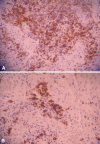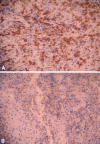Immunologic adverse reaction associated with low-carbide metal-on-metal bearings in total hip arthroplasty
- PMID: 20020335
- PMCID: PMC2895854
- DOI: 10.1007/s11999-009-1187-x
Immunologic adverse reaction associated with low-carbide metal-on-metal bearings in total hip arthroplasty
Abstract
Background: An increased incidence of periprosthetic osteolysis, resulting in loss of biologic fixation, has been reported in contemporary THAs with low-carbide metal-on-metal compared with metal-on-polyethylene couple bearings. Although a hypersensitivity reaction attributable to Co and Cr debris is reportedly a potential cause for failure of THAs with high-carbide bearings, there are no evidence-based data for this reaction in low-carbide metal-on-metal bearings, although such hypersensitivity might be related to osteolysis.
Questions/purposes: We investigated whether there were differences in immunologic hypersensitivity reactions in retrievals from revised THAs with ceramic-on-polyethylene versus metal-on-metal bearing couples.
Patients and methods: We compared newly formed capsule and periprosthetic interface membranes from revision surgery for aseptic failure from 20 patients with low-carbide bearings and 13 patients with ceramic-on-polyethylene bearings. For control tissue, we obtained samples from the hip capsule during the primary THA implantation in 13 patients with low-carbide bearings and seven with ceramic-on-polyethylene bearings. We examined the tissues with conventional histologic and immunohistochemical methods.
Results: Compared with tissue from the control subjects and patients with ceramic-on-polyethylene bearings, the tissues from patients with low-carbide metal-on-metal bearings were associated with (1) extensive necrosis and fibrin exudation in the newly formed hip capsule and (2) diffuse and perivascular lymphocytic infiltration of a higher degree than in the hips with ceramic-on-polyethylene bearings in conventional histologic examination, and (3) more T than B cells.
Conclusions: The conventional histologic and immunohistochemical findings in tissues retrieved from failed THAs with low-carbide metal-on-metal bearings are consistent with a link between hypersensitivity and osteolysis with low-carbide bearing couples.
Figures




References
-
- Boss JH, Misselevich I, Behar J, Mendes DG. Histologic analysis of the periprosthetic tissues of long-term surviving cemented total hip arthroplasties. J Long Term Eff Med Implants. 1996;6:73–90. - PubMed
-
- Brodner W, Bitzan P, Meisinger V, Kaider A, Gottsauner-Wolf F, Kotz R. Serum cobalt levels after metal-on-metal total hip arthroplasty. J Bone Joint Surg Am. 2003;85:2168–2173. - PubMed
-
- Campbell P, McKellop H, Mirra J, Nutt S, Dorr L, Amstutz HC. Metal-on-metal hip replacements: wear performance and cellular response to wear particles. In: Disegi JA, Kennedy RL, Pilliar R, editors. Cobalt-Base Alloys for Biomedical Applications. West Conshohocken, PA: ASTM; 1999. pp. 193–209.
MeSH terms
Substances
LinkOut - more resources
Full Text Sources
Medical

